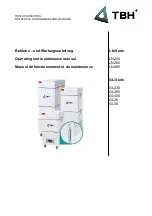
ASE 150 Operator’s Manual
144
Doc. 065207-02 9/08
that might affect the actual extraction temperature. This is an advantage when
compared to microwave extraction, in which the actual pressure and temperature
of the extraction will be influenced strongly by the above mentioned sample
parameters.
Once the cell is in place in the oven, the pump immediately begins to deliver the
solvent of choice to the sample cell. Once solvent has made its way through the
sample cell and reaches the collection vessel, the static valve closes to allow
pressurization of the cell. Since the solvent expands as it heats, the pressure in the
cell will increase when the static valve closes. When the pressure reaches 200 psi
above the set point, the static valve rapidly opens to relieve the pressure and then
closes again. The pump also delivers fresh solvent to the cell in an effort to return
the pressure to the set point value. This addition of fresh solvent during ASE is
analogous to fresh solvent dripping down from the condenser onto the extraction
thimble during Soxhlet extraction.
The first phase of the run is called the heat-up time, as the cell contents are heated
by the oven to the chosen operating temperature. Heat-up times vary between
5 minutes for 100 °C and 9 minutes for 200 °C. After the heat-up time, the
extraction enters a static period with a duration chosen by the user. Typical static
times are 5 minutes, but can vary from 0 to 99 minutes. After the static time, fresh
solvent is pumped through the cell to remove extracted analytes while the sample
and solvent are still hot. The amount used for the rinse can vary from 0% to 150%
of the volume of the cell used for the extraction (40% to 60% is most common).
The user can choose the number of times the sample will be in the static mode,
and this is entered as the number of static cycles. The rinse volume is divided by
the number of static cycles so that fresh solvent is present at the beginning of each
static cycle. In other words, if one static cycle is chosen, the entire rinse volume
will be pumped through the cell at the end of the static time. If three static cycles
are chosen, a third of the total rinse volume will be pumped through the cell at the
conclusion of each static cycle. The number of static cycles can be programmed
from one to five with one cycle being the most common. Following the final
solvent rinse, solvent is purged out of the cell using nitrogen at 150 psi for a
predetermined period of time. The total time for the extraction is usually less than
15 minutes, and the amount of solvent used is approximately 1.5 times the volume
of the sample cell (for example, about 15 mL for the 10-mL cell). The extracts are
delivered to the collection vessels through a filter, and in many cases do not need
any additional preparation prior to analysis. Since the extract is diluted by the total
volume of extraction solvent plus the rinse solvent, sometimes a further
concentration step is required (i.e., evaporation, solid-phase extraction, etc.) when
performing trace analysis.
Содержание ASE 150
Страница 1: ...ASE 150 Accelerated Solvent Extractor Operator s Manual Document No 065207 Revision 02 September 2008...
Страница 32: ...ASE 150 Operator s Manual 24 Doc 065207 02 9 08...
Страница 64: ...ASE 150 Operator s Manual 56 Doc 065207 02 9 08...
Страница 76: ...ASE 150 Operator s Manual 68 Doc 065207 02 9 08...
Страница 114: ...ASE 150 Operator s Manual 106 Doc 065207 02 9 08...
Страница 132: ...ASE 150 Operator s Manual 124 Doc 065207 02 9 08...
















































